

Compact Muon Solenoid
LHC, CERN
| CMS-PAS-FTR-16-005 | ||
| Estimated sensitivity for new particle searches at the HL-LHC | ||
| CMS Collaboration | ||
| July 2017 | ||
| Abstract: Sensitivity projections for new physics searches with 3000 fb−1 of data anticipated at the high-luminosity LHC (HL-LHC) are presented. These results were obtained from dedicated studies performed for the ECFA 2016 upgrade workshop. Projections for heavy vector bosons (Z' and W') decays containing top quarks are obtained by extrapolating Run-2 results assuming scenarios with varying systematic uncertainties. Results for the dark matter and weak production of single vector-like quark searches are obtained by implementing detector performance specifications from the CMS Phase-2 technical proposal in the DELPHES simulation package. | ||
| Links: CDS record (PDF) ; inSPIRE record ; CADI line (restricted) ; | ||
| Figures | |

png pdf |
Figure 1:
The reconstructed tb invariant mass distributions in the 1 b-tag (top) and 2 b-tag (bottom) categories. |
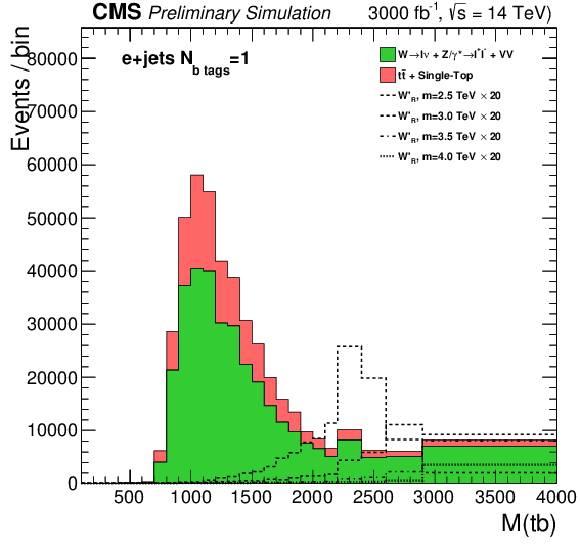
png pdf |
Figure 1-a:
The reconstructed tb invariant mass distributions in the e+jets 1 b-tag category. |

png pdf |
Figure 1-b:
The reconstructed tb invariant mass distributions in the μ+jets 1 b-tag category. |

png pdf |
Figure 1-c:
The reconstructed tb invariant mass distributions in the e+jets 2 b-tag category. |
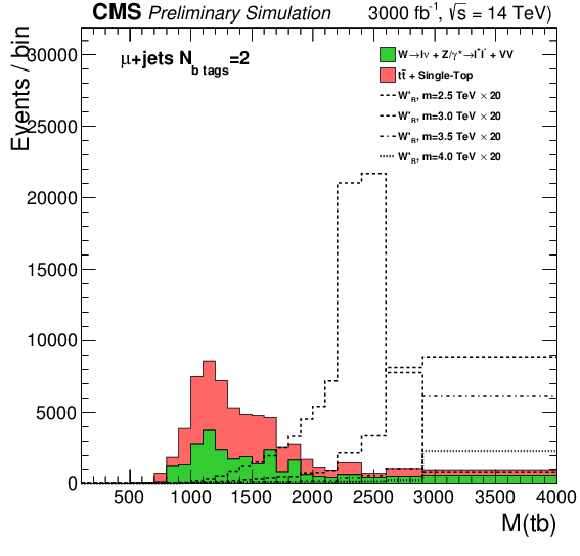
png pdf |
Figure 1-d:
The reconstructed tb invariant mass distributions in the μ+jets 2 b-tag category. |
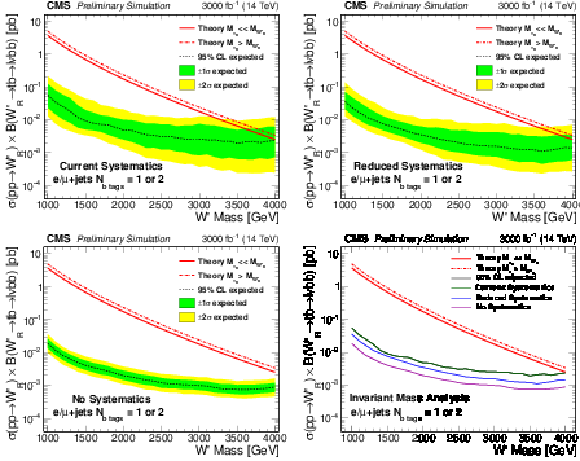
png pdf |
Figure 2:
Projection of expected and observed Bayesian 95% C.L. upper limits on the production cross section times branching ratio of right-handed W' bosons for an integrated luminosity of 3000 fb−1. The projection combines electron/muon+jets channel and 1 or 2 b-tags. The "current systematic" scenario (top-left) assumes no change in systematics from the 12.9 fb−1 dataset [9] used for projection. The "reduced systematic" scenario (top-right) assumes a realistic reduction from their nominal values. For the graph on the bottom-left, no systematic uncertainties are included. Theoretical W' cross sections times branching ratios for two different theoretical assumptions on the right-handed neutrino mass are shown in red. Bottom-right: the three different uncertainty scenarios in the same figure. |
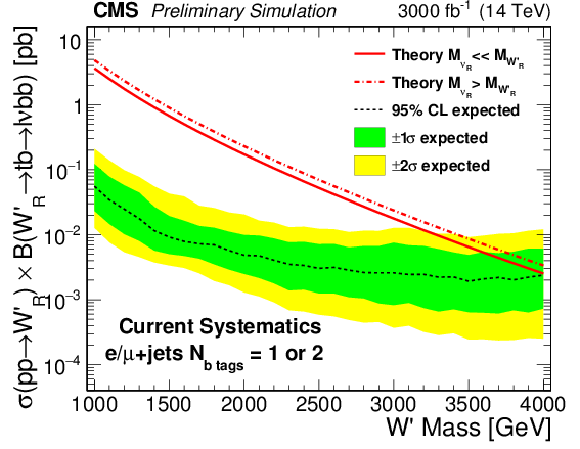
png pdf |
Figure 2-a:
Projection of expected and observed Bayesian 95% C.L. upper limits on the production cross section times branching ratio of right-handed W' bosons for an integrated luminosity of 3000 fb−1. The projection combines electron/muon+jets channel and 1 or 2 b-tags. The "current systematic" scenario assumes no change in systematics from the 12.9 fb−1 dataset [9] used for projection. |
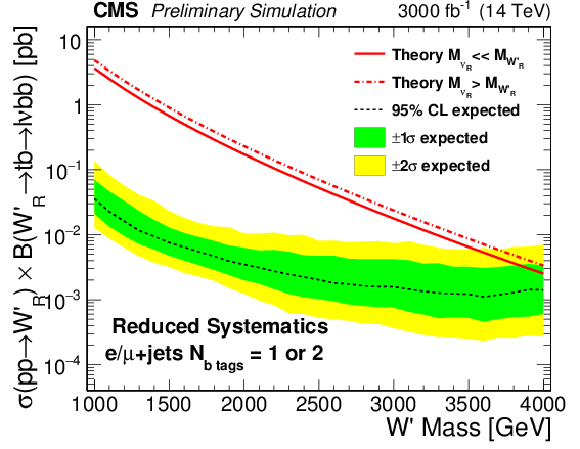
png pdf |
Figure 2-b:
Projection of expected and observed Bayesian 95% C.L. upper limits on the production cross section times branching ratio of right-handed W' bosons for an integrated luminosity of 3000 fb−1. The projection combines electron/muon+jets channel and 1 or 2 b-tags. The "reduced systematic" scenario assumes a realistic reduction from their nominal values. |

png pdf |
Figure 2-c:
Projection of expected and observed Bayesian 95% C.L. upper limits on the production cross section times branching ratio of right-handed W' bosons for an integrated luminosity of 3000 fb−1. The projection combines electron/muon+jets channel and 1 or 2 b-tags. No systematic uncertainties are included. Theoretical W' cross sections times branching ratios for two different theoretical assumptions on the right-handed neutrino mass are shown in red. |
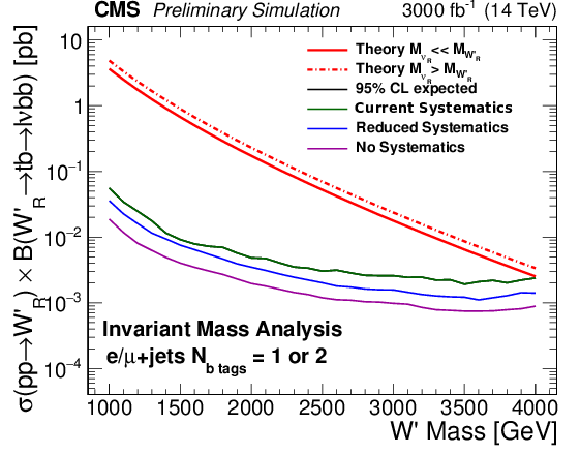
png pdf |
Figure 2-d:
Projection of expected and observed Bayesian 95% C.L. upper limits on the production cross section times branching ratio of right-handed W' bosons for an integrated luminosity of 3000 fb−1. The projection combines electron/muon+jets channel and 1 or 2 b-tags. Three different uncertainty scenarios in the same figure. |
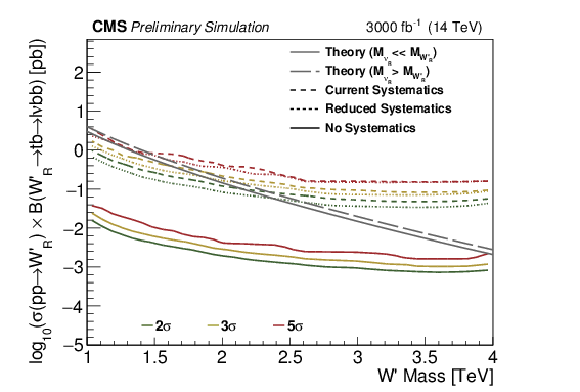
png pdf |
Figure 3:
Expected discovery sensitivity for an integrated luminosity of 3000 fb−1 as a function of the signal mass and the production cross section times branching ratio of right-handed W' bosons in the combined electron/muon+jets channel, for combined 1 or 2 b-tags. Three scenarios for systematic are shown as explained in the legend. Theoretical W' cross sections times branching ratios for two different theoretical assumptions on the right-handed neutrino mass are shown in grey (solid and dashed lines). |
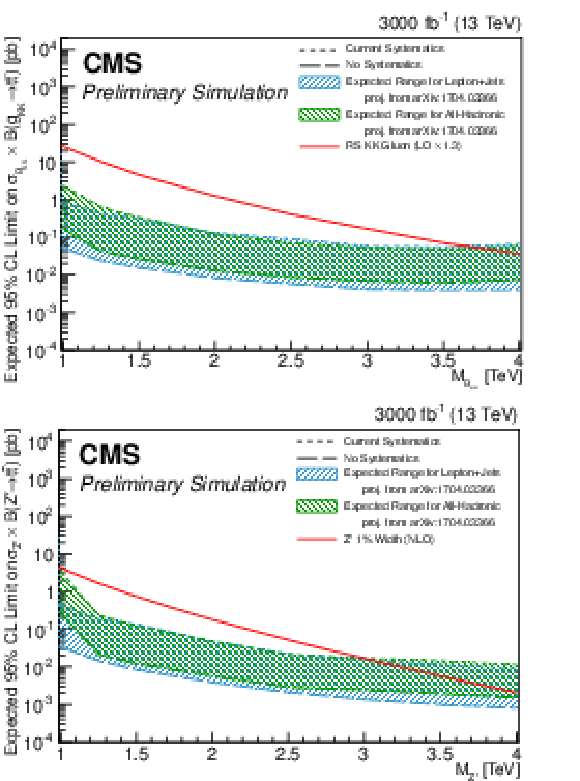
png pdf |
Figure 4:
Projected ranges of cross section limits expected for 3000 fb−1 of HL-LHC running, shown individually for the lepton+jets (blue) and all-hadronic event (green) categories. The short-dashed line shows the median expected limits using full systematics from the Run-2 analyses [17] assuming no improvements in systematic uncertainties. The long-dashed line shows the same when applying no systematic uncertainties. |
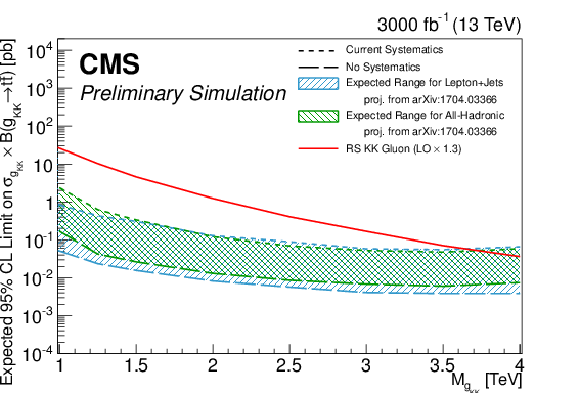
png pdf |
Figure 4-a:
Projected ranges of cross section limits expected for 3000 fb−1 of HL-LHC running, shown individually for the lepton+jets (blue) and all-hadronic event (green) categories. The short-dashed line shows the median expected limits using full systematics from the Run-2 analyses [17] assuming no improvements in systematic uncertainties. The long-dashed line shows the same when applying no systematic uncertainties. |
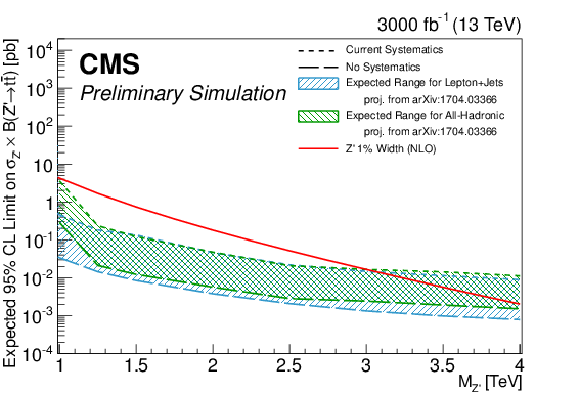
png pdf |
Figure 4-b:
Projected ranges of cross section limits expected for 3000 fb−1 of HL-LHC running, shown individually for the lepton+jets (blue) and all-hadronic event (green) categories. The short-dashed line shows the median expected limits using full systematics from the Run-2 analyses [17] assuming no improvements in systematic uncertainties. The long-dashed line shows the same when applying no systematic uncertainties. |

png pdf |
Figure 5:
Discovery sensitivities for the lepton+jets channel (left column) and all-hadronic channel (right column), for 3000 fb−1. The results are presented in the plane of the cross section versus the resonance mass, with the color contours representing the boundaries of areas with significances larger than 2, 3, or 5 standard deviations. The results are shown for the narrow-width signal hypothesis (top row) and RS KK gluon signal hypothesis (bottom row), with the "current systematic" uncertainties scenario from the Run-2 analysis [17] shown by the dashed lines and the "no systematic uncertainties" scenario shown by the solid lines. |
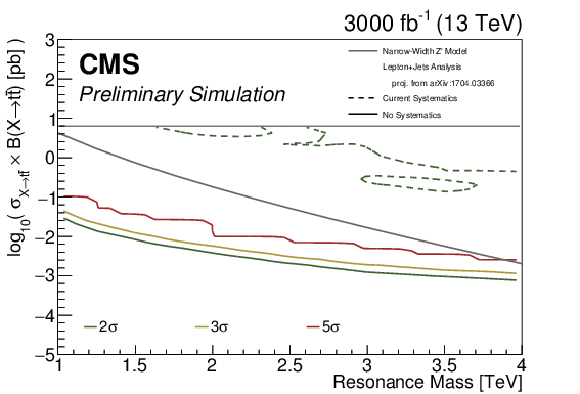
png pdf |
Figure 5-a:
Discovery sensitivities for the lepton+jets channel, for 3000 fb−1. The results are presented in the plane of the cross section versus the resonance mass, with the color contours representing the boundaries of areas with significances larger than 2, 3, or 5 standard deviations. The results are shown for the narrow-width signal hypothesis, with the "current systematic" uncertainties scenario from the Run-2 analysis [17] shown by the dashed lines and the "no systematic uncertainties" scenario shown by the solid lines. |
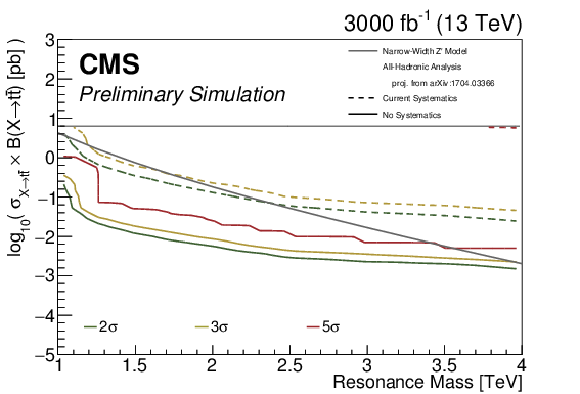
png pdf |
Figure 5-b:
Discovery sensitivities for the all-hadronic channel, for 3000 fb−1. The results are presented in the plane of the cross section versus the resonance mass, with the color contours representing the boundaries of areas with significances larger than 2, 3, or 5 standard deviations. The results are shown for the narrow-width signal hypothesis, with the "current systematic" uncertainties scenario from the Run-2 analysis [17] shown by the dashed lines and the "no systematic uncertainties" scenario shown by the solid lines. |
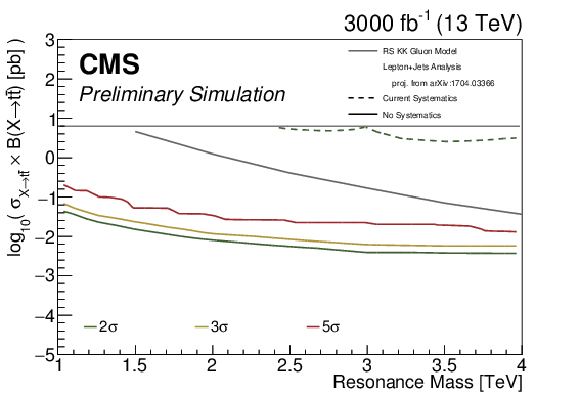
png pdf |
Figure 5-c:
Discovery sensitivities for the lepton+jets channel, for 3000 fb−1. The results are presented in the plane of the cross section versus the resonance mass, with the color contours representing the boundaries of areas with significances larger than 2, 3, or 5 standard deviations. The results are shown for the RS KK gluon signal hypothesis, with the "current systematic" uncertainties scenario from the Run-2 analysis [17] shown by the dashed lines and the "no systematic uncertainties" scenario shown by the solid lines. |
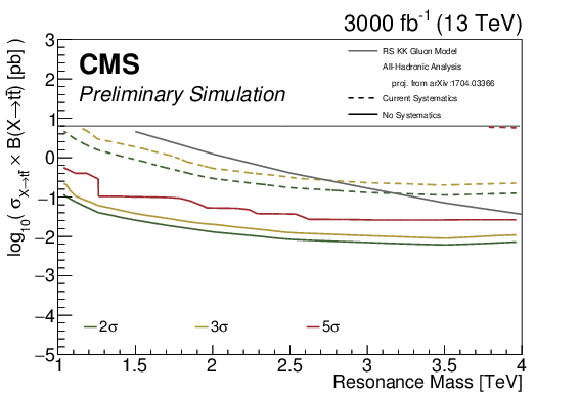
png pdf |
Figure 5-d:
Discovery sensitivities for the all-hadronic channel, for 3000 fb−1. The results are presented in the plane of the cross section versus the resonance mass, with the color contours representing the boundaries of areas with significances larger than 2, 3, or 5 standard deviations. The results are shown for the RS KK gluon signal hypothesis, with the "current systematic" uncertainties scenario from the Run-2 analysis [17] shown by the dashed lines and the "no systematic uncertainties" scenario shown by the solid lines. |
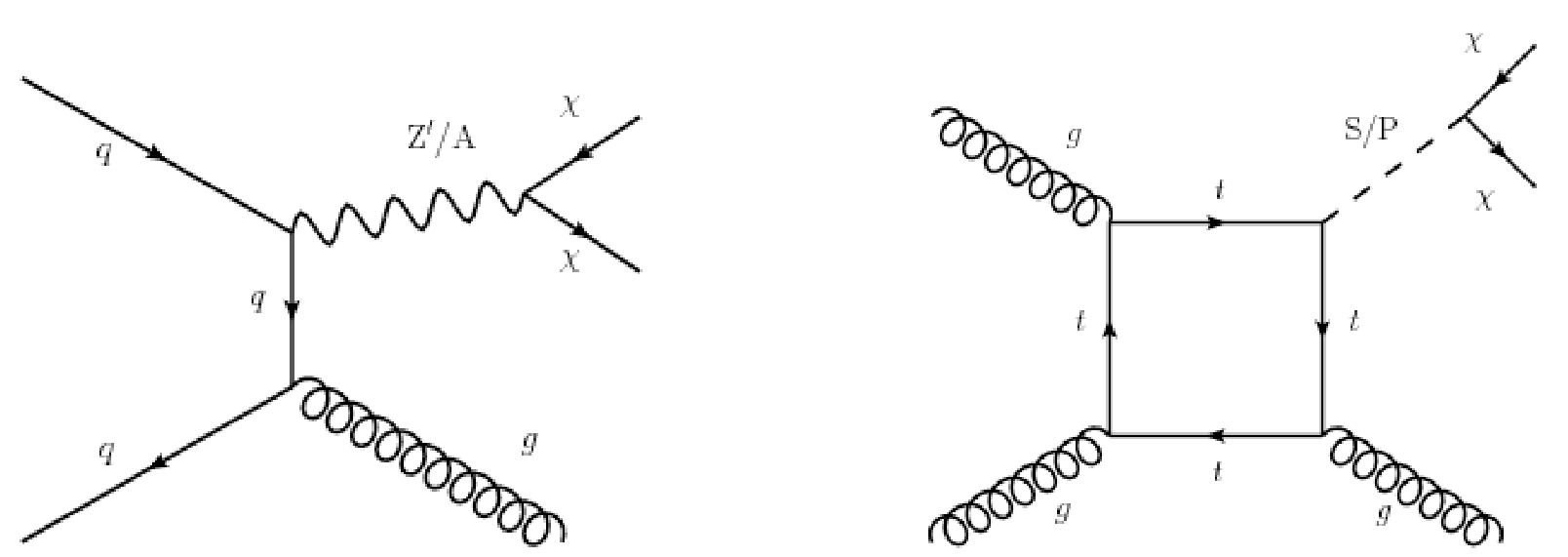
png pdf |
Figure 6:
Feynman diagrams of DM pair production for an axial vector and pseudoscalar mediated interaction. |
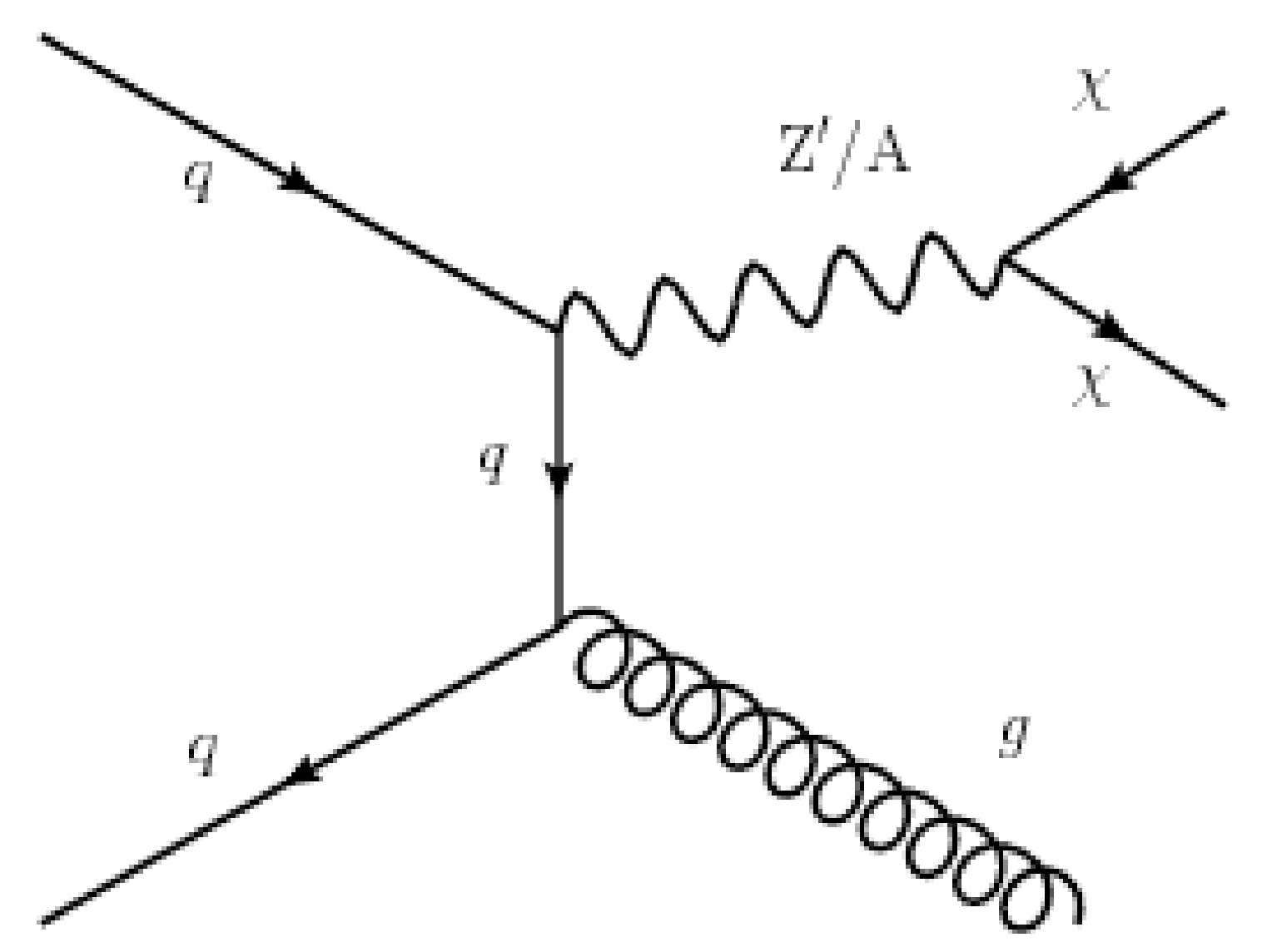
png pdf |
Figure 6-a:
Feynman diagram of DM pair production for an axial vector mediated interaction. |
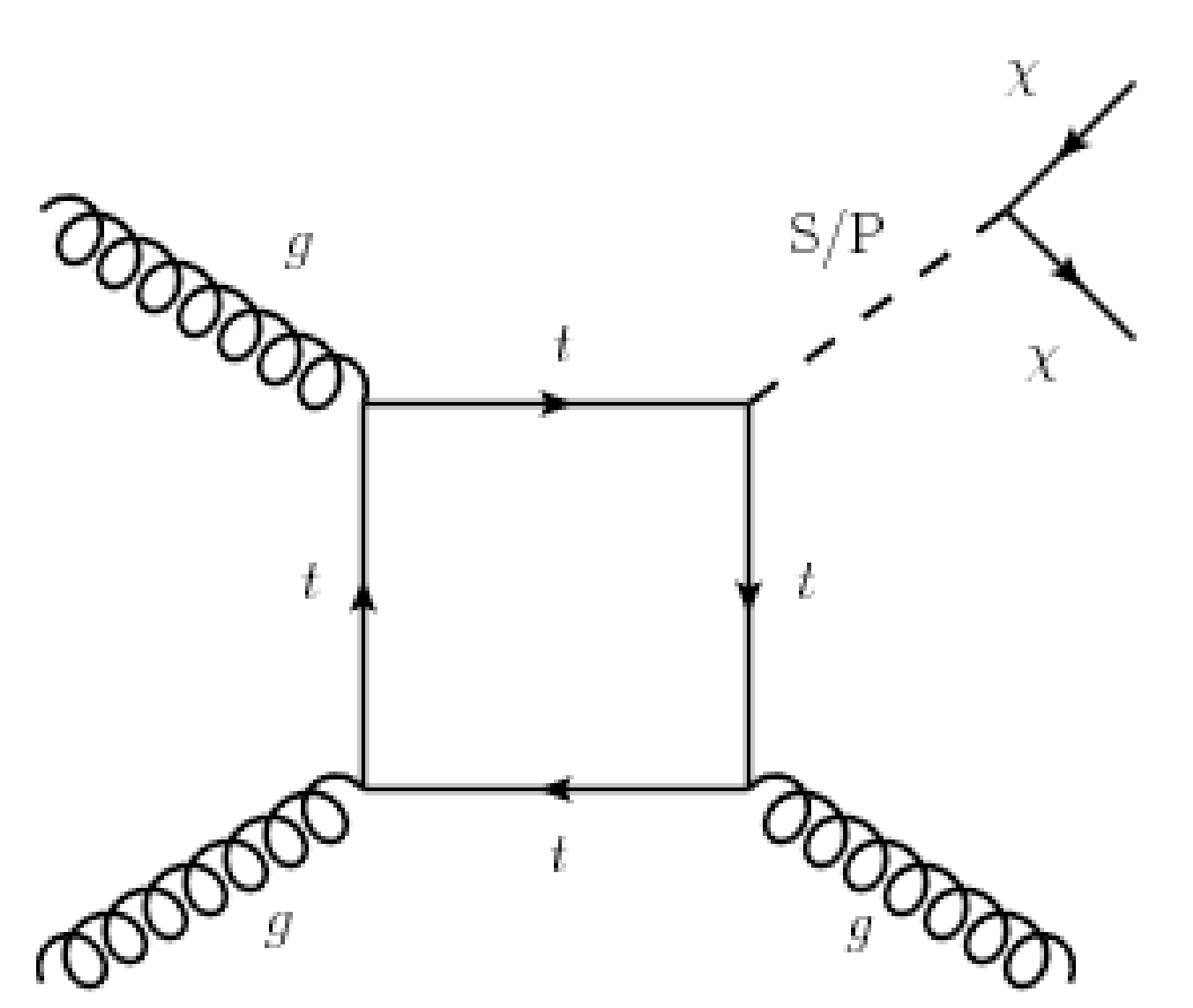
png pdf |
Figure 6-b:
Feynman diagram of DM pair production for a pseudoscalar mediated interaction. |
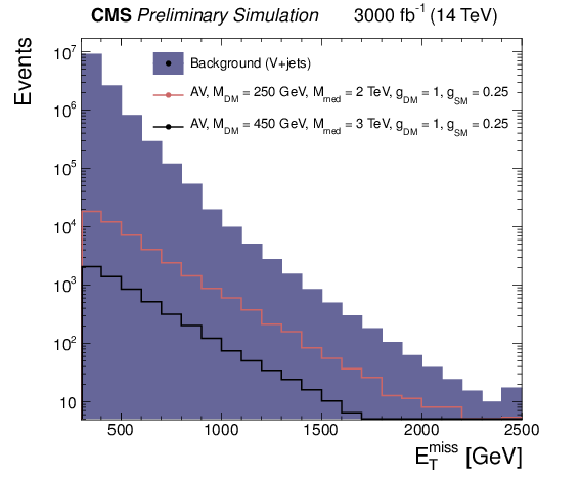
png pdf |
Figure 7:
Distribution of the discriminating variable, EmissT, after full event selection. The V+jets background is taken from simulation. Two signal examples are shown for the axial vector model with the model parameters given in the legend. |
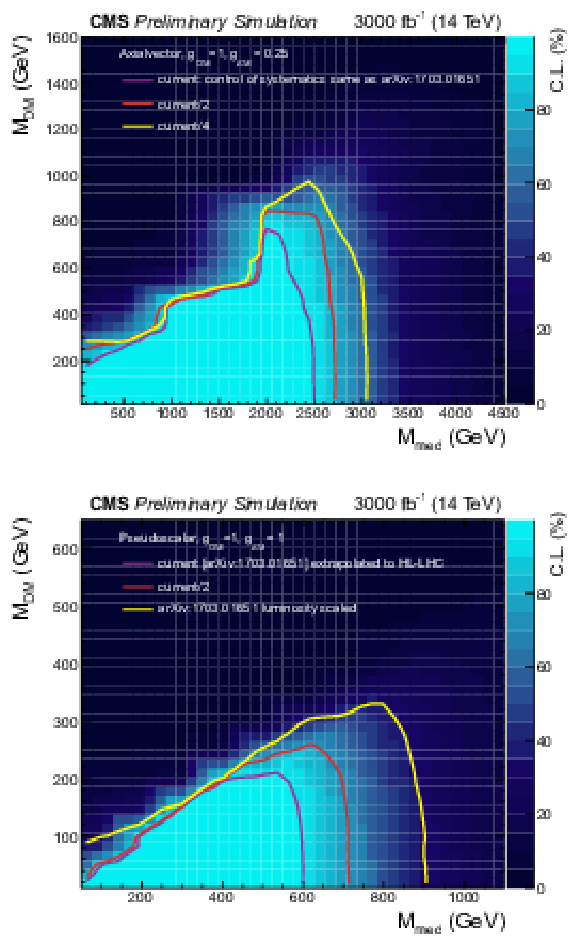
png pdf |
Figure 8:
Projected exclusion limits at 95% C.L. for 3000 fb−1 of HL-LHC statistics for two simplified dark matter models using the monojet analysis. On top the axial vector mediated simplified DM model (gDM= 1, gSM= 0.25), on the bottom the pseudoscalar mediated model (gDM= 1, gSM= 1). The limits are shown for three systematic scenarios. For the AV model: a "current" scenario assumes that the level of systematic control in the high EmissT region is the same as the Run-2 analysis [18], while the "current/2" scenario scales it down by a factor of 2, and the "current/4" scenario by a factor of 4. For the PS model: a "current" scenario where the low EmissT region is dominated by systematic uncertainties and the uncertainties in the high EmissT region are taken from the Run-2 analysis and scaled by luminosity, the "current/2" scenario is the nominal systematics scaled down by a factor of 2, and the "luminosity scaled" scenario takes the uncertainties from the current analysis and scales by luminosity for the full EmissT range. |
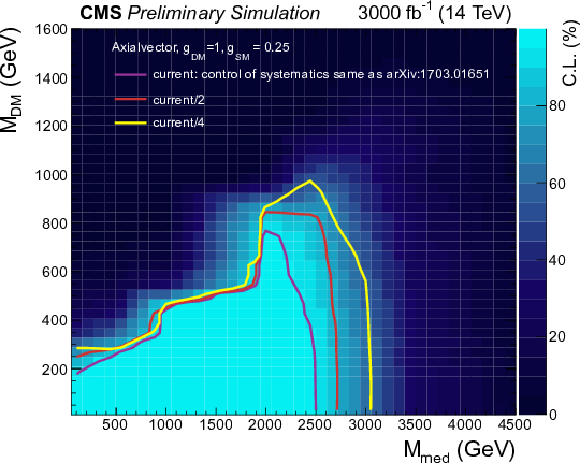
png pdf |
Figure 8-a:
Projected exclusion limits at 95% C.L. for 3000 fb−1 of HL-LHC statistics for two simplified dark matter models using the monojet analysis for the axial vector mediated simplified DM model (gDM= 1, gSM= 0.25). The limits are shown for three systematic scenarios. For the AV model: a "current" scenario assumes that the level of systematic control in the high EmissT region is the same as the Run-2 analysis [18], while the "current/2" scenario scales it down by a factor of 2, and the "current/4" scenario by a factor of 4. For the PS model: a "current" scenario where the low EmissT region is dominated by systematic uncertainties and the uncertainties in the high EmissT region are taken from the Run-2 analysis and scaled by luminosity, the "current/2" scenario is the nominal systematics scaled down by a factor of 2, and the "luminosity scaled" scenario takes the uncertainties from the current analysis and scales by luminosity for the full EmissT range. |

png pdf |
Figure 8-b:
Projected exclusion limits at 95% C.L. for 3000 fb−1 of HL-LHC statistics for two simplified dark matter models using the monojet analysis for the pseudoscalar mediated model (gDM= 1, gSM= 1). The limits are shown for three systematic scenarios. For the AV model: a "current" scenario assumes that the level of systematic control in the high EmissT region is the same as the Run-2 analysis [18], while the "current/2" scenario scales it down by a factor of 2, and the "current/4" scenario by a factor of 4. For the PS model: a "current" scenario where the low EmissT region is dominated by systematic uncertainties and the uncertainties in the high EmissT region are taken from the Run-2 analysis and scaled by luminosity, the "current/2" scenario is the nominal systematics scaled down by a factor of 2, and the "luminosity scaled" scenario takes the uncertainties from the current analysis and scales by luminosity for the full EmissT range. |

png pdf |
Figure 9:
Example production diagrams. Charged-current (left) and neutral current (right). |
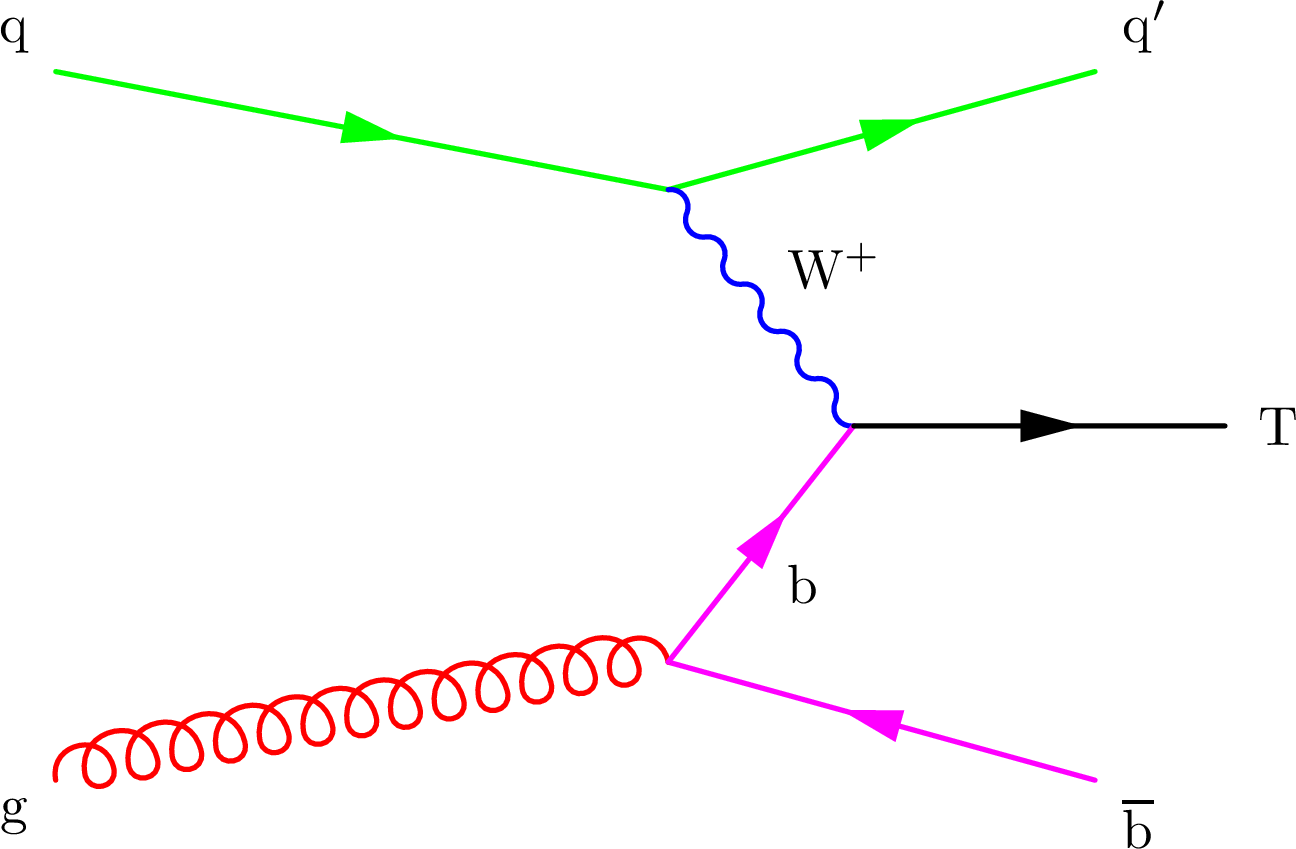
png pdf |
Figure 9-a:
Example production diagram for charged-current. |

png pdf |
Figure 9-b:
Example production diagram for neutral current. |
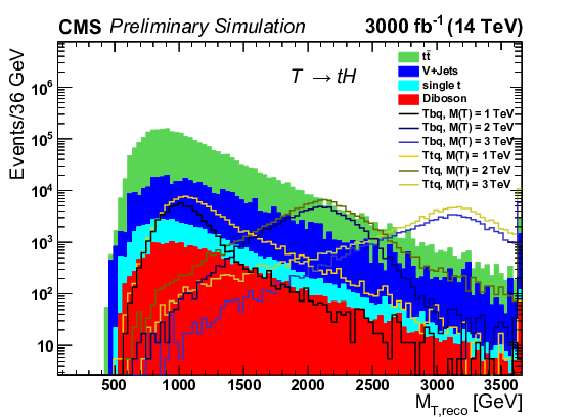
png pdf |
Figure 10:
Distributions of the reconstructed mass of the T quark decaying into a top quark and a Higgs boson. The top quark further decays leptonically and the Higgs boson into a pair of b¯b quarks, leading to the final state of qg→(ℓνb)(b¯b)(¯bq′/¯tq′). Selected signal samples of {\rm T} masses of 1, 2, and 3 TeV from the processes pp→Tbq (Ttq), with left-handed (right-handed) couplings to the SM third generation quarks are overlaid on the total estimated background. |
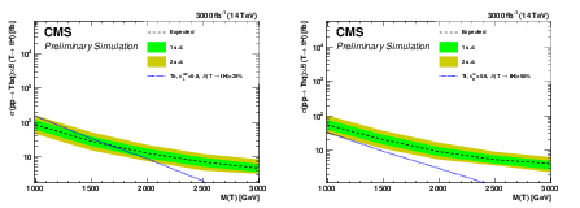
png pdf |
Figure 11:
The expected limits at 95% C.L. on the σ×B( {\rm T} → tH) of a {\rm T} quark for different mass assumption of 1, 1.5, 2, 2.5, and 3 TeV, at an integrated luminosity of 3000 fb−1. The left (right) plot shows the results for the process pp→Tbq (pp→Ttq) with left-handed (right-handed) coupling to the third generation SM quarks as described in models in Refs. [23,33]. The dotted blue line in left (right) plot is the theory cross section assuming 0.5 coupling strength of the T quark to a W (Z) boson, and B(T→tH= 0.25(0.50)), and is obtained by scaling the NLO cross sections at 13 TeV to the k-factor obtained at 14 TeV with CTEQ6L PDF. |
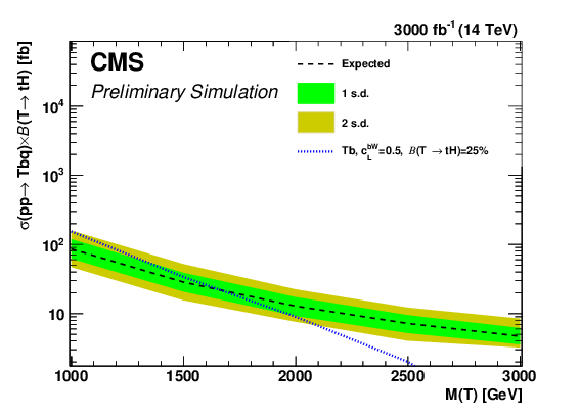
png pdf |
Figure 11-a:
The expected limits at 95% C.L. on the σ×B( {\rm T} → tH) of a {\rm T} quark for different mass assumption of 1, 1.5, 2, 2.5, and 3 TeV, at an integrated luminosity of 3000 fb−1. The lplot shows the results for the process pp→Tbq (pp→Ttq) with left-handed) coupling to the third generation SM quarks as described in models in Refs. [23,33]. The dotted blue line in left (right) plot is the theory cross section assuming 0.5 coupling strength of the T quark to a W (Z) boson, and B(T→tH= 0.25(0.50)), and is obtained by scaling the NLO cross sections at 13 TeV to the k-factor obtained at 14 TeV with CTEQ6L PDF. |
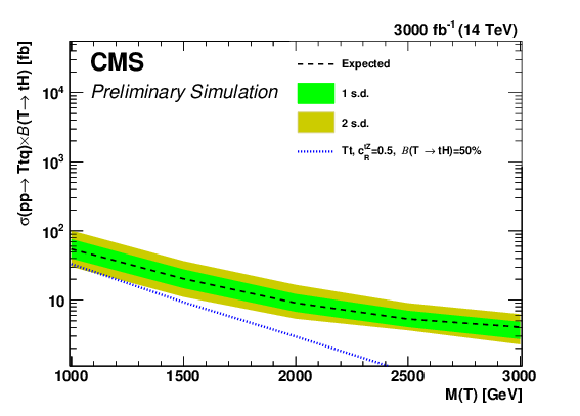
png pdf |
Figure 11-b:
The expected limits at 95% C.L. on the σ×B( {\rm T} → tH) of a {\rm T} quark for different mass assumption of 1, 1.5, 2, 2.5, and 3 TeV, at an integrated luminosity of 3000 fb−1. The lplot shows the results for the process pp→Tbq (pp→Ttq) with right-handed) coupling to the third generation SM quarks as described in models in Refs. [23,33]. The dotted blue line in left (right) plot is the theory cross section assuming 0.5 coupling strength of the T quark to a W (Z) boson, and B(T→tH= 0.25(0.50)), and is obtained by scaling the NLO cross sections at 13 TeV to the k-factor obtained at 14 TeV with CTEQ6L PDF. |
| Tables | |
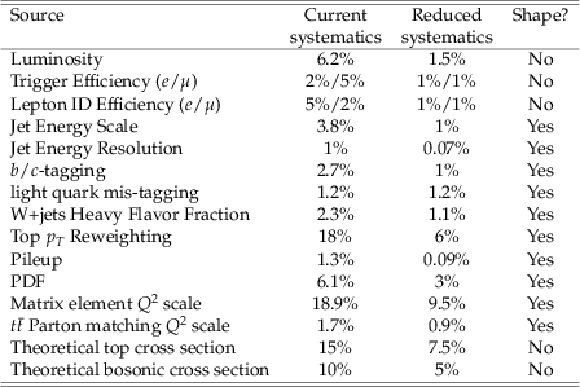
png pdf |
Table 1:
Systematic uncertainties in two scenarios used for extrapolating from results using 12.9 fb−1 of data collected at √s= 13 TeV [9]. The "current systematic" scenario assumes no change in systematics from their nominal values in the 12.9 fb−1 dataset used for projection. The "reduced systematic" scenario assumes a realistic reduction in the magnitude of systematic uncertainties from their nominal values, based on improvements in dataset size, detector performance, and theoretical accuracy among others. For systematics which affect the shape of the invariant mass distribution, the value quoted for the rate uncertainty is approximate. |

png pdf |
Table 2:
Event categories used in the combination, from each of the two channels. Δy represents the rapidity separation between the two top-tagged jets in the all-hadronic channel. |

png pdf |
Table 3:
Summary of the event selection criteria used to select monojet events for this analysis. |

png pdf |
Table 4:
The median expected upper limits at 95% C.L. on the cross section×B(T→ tH) of the {\rm T} quark for the models pp→Tbq (Tbq) with B(T→ tH = 0.25) and pp→Ttq (Ttq) with B(T→ tH = 0.50) for different mass hypotheses and left-handed or right-handed couplings respectively. An integrated luminosity of 3000 fb−1 at proton-proton collision at √s= 14 TeV is assumed. |
| Summary |
|
The physics reach with 3000 fb−1 of HL-LHC data is studied in a number of searches for new physics. The projections described here demonstrate the gain from high-luminosity. Discovering the nature of DM is an important problem in physics. The LHC is performing collider searches for dark matter and its mediators. One of the most common searches is the monojet search with j+MET in the final state. Based on the Run-2 event selection, the analysis for the two interesting couplings scenarios, namely the axial vector and pseudoscalar coupling, is performed. The precise knowledge of systematic uncertainties has a significant impact on the reach in mediator mass which corresponds to 2.5 TeV without any improvement of the present understanding of the systematic uncertainties. If, on the contrary, the systematics improves by 1/4 the sensitivity increases by 20% to 3 TeV. Projections of searches are performed for new heavy vector bosons (Z' and W') at the HL-LHC. Analyses performed on the 13 TeV data are projected to the HL-LHC data set of 3000 fb−1 to determine the maximum reach of excluded boson masses as well as the discovery reach. The projections are performed under different scenarios considering systematic uncertainties. A promising search is for a right-handed W'R in the decay channel to tb yielding final states of an electron or muon together with one or two b-tagged jets. The maximum reach in terms of boson mass is 4 TeV with present systematics and above with improved systematics. In addition, model independent discovery sensitivities are presented. The projected Z′→tˉt exclusion limits are also around 3-4 TeV, depending on the widths of the new resonance and the knowledge of systematics. Two different widths are studied, Γ= 1% for a SSM Z' and 16% for a RS KK gluon. The expectation is to exclude the narrow Z' model up to 3.3 TeV masses, and the RS KK Gluon model up to 4 TeV in the scenario of Run-2 systematics. In the best case scenario of only statistical uncertainties, the reach extends for both models beyond 4 TeV pushing into a region where the analysis strategy has to be adapted to accommodate the increasing off-shell component for high resonance masses. The discovery of the Higgs boson provided theoretical constraints to physics beyond the SM and also opens new decay channels for searches. As one example, this document presents a search for weakly produced single vector like quarks (T) decaying to a t-quark and a Higgs boson. Since both particles decay further, this challenging analysis has to reconstruct them from the final state consisting of a lepton, EmissT and up to four b-quarks. Due to the forward going jets an increased sensitivity is expected from the extended acceptance of the Phase-2 detector. Considering simplest Simplified Model for a singlet and a doublet T quark, two scenarios are considered for signal interpretation: LH coupling cbWL with B(T→ bW) : B(T→ tZ) : B(T→ tH) = 0.5 : 0.25 : 0.25 for the singlet {\rm T} quark, and RH coupling ctZR with B(T→ bW) : B(T→ tZ) : B(T→ tH) = 0.0 : 0.5 : 0.5 for the doublet {\rm T} quark. The expected upper cross section limits range from 85.9 fb (54.7 fb) for a {\rm T} mass of 1 TeV to 4.7 fb (4.1 fb) for a {\rm T} mass of 3 TeV for the singlet (doublet) T quark. |
| References | ||||
| 1 | ECFA conference | ECFA High Luminosity LHC Experiments Workshop 2016 | link | |
| 2 | CMS Collaboration | Projected performance of Higgs analyses at the HL-LHC for ECFA 2016 | CMS-PAS-FTR-16-002 | |
| 3 | CMS Collaboration | ECFA 2016: selected standard model measurements with the CMS experiment at the high-luminosity LHC | CMS-PAS-FTR-16-006 | |
| 4 | J. Butler et al. | Technical Proposal for the Phase-II Upgrade of the CMS Detector | CERN-LHCC-2015-010. LHCC-P-008, CERN | |
| 5 | CMS Collaboration | Enhanced scope of a Phase 2 CMS detector for the study of exotic physics signatures at the HL-LHC | CMS-PAS-EXO-14-007 | |
| 6 | DELPHES 3 Collaboration | DELPHES 3, A modular framework for fast simulation of a generic collider experiment | JHEP 1402 (2014) 057 | 1307.6346 |
| 7 | J. L. Rosner et al. | Planning the Future of U.S. Particle Physics (Snowmass 2013): Chapter 1: Summary | in Proceedings, Community Summer Study 2013: Snowmass on the Mississippi (CSS2013): Minneapolis, 2013 | 1401.6075 |
| 8 | G. Altarelli, B. Mele, and M. Ruiz-Altaba | Searching for new heavy vector bosons in pˉp colliders | Z. Phys. C 45 (1989) 109 | |
| 9 | CMS Collaboration | Search for W' boson resonances decaying into a top quark and a bottom quark in the leptonic final state at √s= 13 TeV | CMS-PAS-B2G-16-017 | CMS-PAS-B2G-16-017 |
| 10 | M. Cacciari, G. P. Salam, and G. Soyez | The Anti-k(t) jet clustering algorithm | JHEP 04 (2008) 063 | 0802.1189 |
| 11 | M. Cacciari, G. P. Salam, and G. Soyez | FastJet user manual | EPJC 72 (2012) 1896 | 1111.6097 |
| 12 | CMS Collaboration | Search for tˉt resonances in boosted semileptonic final states in pp collisions at √s= 13 TeV | CMS-PAS-B2G-15-002 | |
| 13 | CMS Collaboration | Search for top quark-antiquark resonances in the all-hadronic final state at √s= 13 TeV | CMS-PAS-B2G-15-003 | |
| 14 | R. Bonciani et al. | Electroweak top-quark pair production at the LHC with Z' bosons to NLO QCD in POWHEG | JHEP 02 (2016) 141 | 1511.08185 |
| 15 | K. Agashe et al. | LHC Signals from Warped Extra Dimensions | PRD77 (2008) 015003 | hep-ph/0612015 |
| 16 | J. Ott | Theta---a framework for template-based modeling and inference | link | |
| 17 | CMS Collaboration | Search for tˉt resonances in highly-boosted lepton+jets and fully hadronic final states in proton-proton collisions at √s= 13 TeV | CMS-B2G-16-015 1704.03366 |
|
| 18 | CMS Collaboration | Search for dark matter produced with an energetic jet or a hadronically decaying W or Z boson at √s= 13 TeV | CMS-EXO-16-037 1703.01651 |
|
| 19 | U. Haisch, F. Kahlhoefer, and E. Re | QCD effects in mono-jet searches for dark matter | JHEP 12 (2013) 007 | 1310.4491 |
| 20 | U. Haisch and E. Re | Simplified dark matter top-quark interactions at the LHC | JHEP 06 (2015) 078 | 1503.00691 |
| 21 | J. A. Aguilar-Saavedra, R. Benbrik, S. Heinemeyer, and M. Perez-Victoria | Handbook of vectorlike quarks: Mixing and single production | PRD88 (2013), no. 9, 094010 | 1306.0572 |
| 22 | CMS Collaboration | Search for vector-like charge 2/3 T quarks in proton-proton collisions at √s= 8 TeV | CMS-B2G-13-005 1509.04177 |
|
| 23 | J. Matsedonskyi, G. Panico, and A. Wulzer | On the Interpretation of Top Partners Searches | JHEP 12 (2014) 097 | 1409.0100 |
| 24 | J. Alwall et al. | MadGraph 5 : Going Beyond | JHEP 06 (2011) 128 | 1106.0522 |
| 25 | T. Sjostrand et al. | An Introduction to PYTHIA 8.2 | CPC 191 (2015) | 1410.3012 |
| 26 | NNPDF Collaboration | Parton distributions for the LHC Run II | JHEP 04 (2015) 040 | 1410.8849 |
| 27 | J. Thaler and K. Van Tilburg | Identifying Boosted Objects with N-subjettiness | JHEP 03 (2011) 015 | 1011.2268 |
| 28 | CMS Collaboration | Search for single production of a heavy vector-like T quark decaying to a Higgs boson and a top quark with a lepton and jets in the final state | PLB771 (2017) 80--105 | CMS-B2G-15-008 1612.00999 |
| 29 | ATLAS and CMS Collaborations and LHC Higgs Combination Group | Procedure for the LHC Higgs boson search combination in summer 2011 | ATL-PHYS-PUB-2011-011, CMS NOTE 2011/005 | |
| 30 | B. W. Lee, C. Quigg, and H. B. Thacker | Weak Interactions at Very High-Energies: The Role of the Higgs Boson Mass | PRD16 (1977) 1519 | |
| 31 | B. W. Lee, C. Quigg, and H. B. Thacker | The Strength of Weak Interactions at Very High-Energies and the Higgs Boson Mass | PRL 38 (1977) 883--885 | |
| 32 | M. S. Chanowitz and M. K. Gaillard | The tev physics of strongly interacting w's and z's | Nuclear Physics B 261 (1985) 379--431 | |
| 33 | J. M. Campbell, R. K. Ellis, and F. Tramontano | Single top production and decay at next-to-leading order | PRD70 (2004) 094012 | hep-ph/0408158 |

|
Compact Muon Solenoid LHC, CERN |

|

|

|

|

|

|